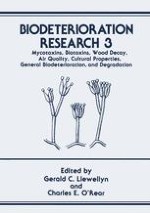1990 | OriginalPaper | Buchkapitel
Sapstreak Disease and Biodeterioration of Sugar Maple
verfasst von : Kevin T. Smith
Erschienen in: Biodeterioration Research
Verlag: Springer US
Enthalten in: Professional Book Archive
Aktivieren Sie unsere intelligente Suche, um passende Fachinhalte oder Patente zu finden.
Wählen Sie Textabschnitte aus um mit Künstlicher Intelligenz passenden Patente zu finden. powered by
Markieren Sie Textabschnitte, um KI-gestützt weitere passende Inhalte zu finden. powered by
Logs and lumber decrease in value due to fungi that stain wood as well as from fungi that cause decay. Sapwood within a living tree is subject to a number of discoloring or staining processes involved with tree defense and fungal infection (Shortle, 1984). Although the use of color to typify wood tissues can result in confusion (Shigo, 1986), changes in color are indicative of distinct metabolic processes that once located may then be more precisely characterized. Sap stains are sapwood tissues altered in color due to fungal activity and may occur in the standing tree, cut lumber, or manufactured product (Scheffer and Lindgren, 1940). The sapstreak disease of sugar maple results in a sap stain in the tree that persists in the wood product. Although wood strength is not affected by sapstreak, the stain lowers the commercial value of affected lumber (Ohman and Spike, 1966).
